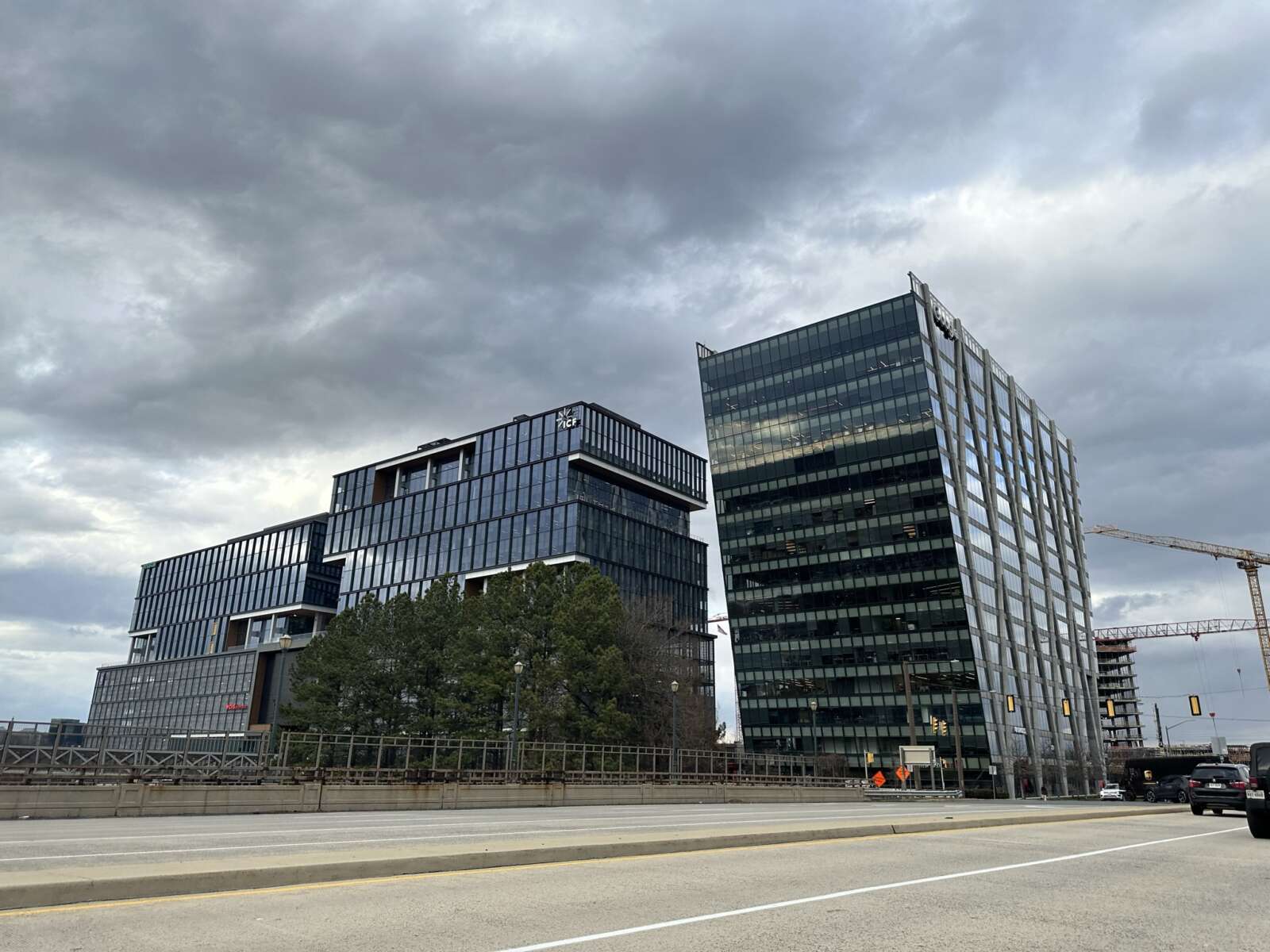
Updated at 8:40 p.m. on 11/8/2023 — The community workshop has been relocated to the cafeteria of Langston Hughes Middle School (11401 Ridge Heights Road).
Earlier: Fairfax County is formally launching a new study on how to shift Wiehle Avenue from a car-dominated, suburban road to a multimodal, urban street.
The Wiehle Avenue study kicks off with an in-person community workshop on Nov. 13.
After diving into the background and purpose of the study, the county will open the floor for attendees to brainstorm ideas on how to improve the road between Sunrise Valley Drive and the Washington & Old Dominion Trail in Reston.
The ideas proposed by the community will later be refined into three concepts “to test in future (year 2030) scenarios” by the Fairfax County Department of Transporation and its consultant, Fehr & Peers, FCDOT spokesperson Freddy Serrano says.
“[The scenarios] will give us an overview of how potential changes may affect traffic operations and accessibility and comfort for pedestrians, bicyclists, and transit users,” Serrano told FFXnow. “We will take these concepts and the resulting future analysis back to the public early next year and will solicit their feedback to arrive at a preferred concept for Wiehle Avenue.”
The Fairfax County Board of Supervisors initiated the Wiehle Avenue study as a follow-on motion after approving TF Cornerstone’s Campus Commons redevelopment plan in 2019.
The project prompted vigorous debate on the safety of a proposed pedestrian crossing at the intersection Dulles Toll Road ramps and Wiehle Avenue. An alternative is being explored after the developer offered $1.65 million instead of developing a solution.
The county previously convened a study group to evaluate options for that crossing, but the group didn’t support any of the developer’s proposals.
FCDOT says this new study will take a broader look at the corridor and how it may have been affected by the opening of Metro’s Silver Line extension last year.
“This effort is expected to identify new and improved bicycle/pedestrian facilities and intersection treatments, as well as evaluate the potential reconfiguration of vehicular lanes and/or widths for current and future land use scenarios,” the department said in a news release.
The community meeting takes place from 5:30-9 p.m. in the second floor conference room of 1900 Reston Metro Plaza. A light dinner will be provided. RSVPs are encouraged through an online feedback form.
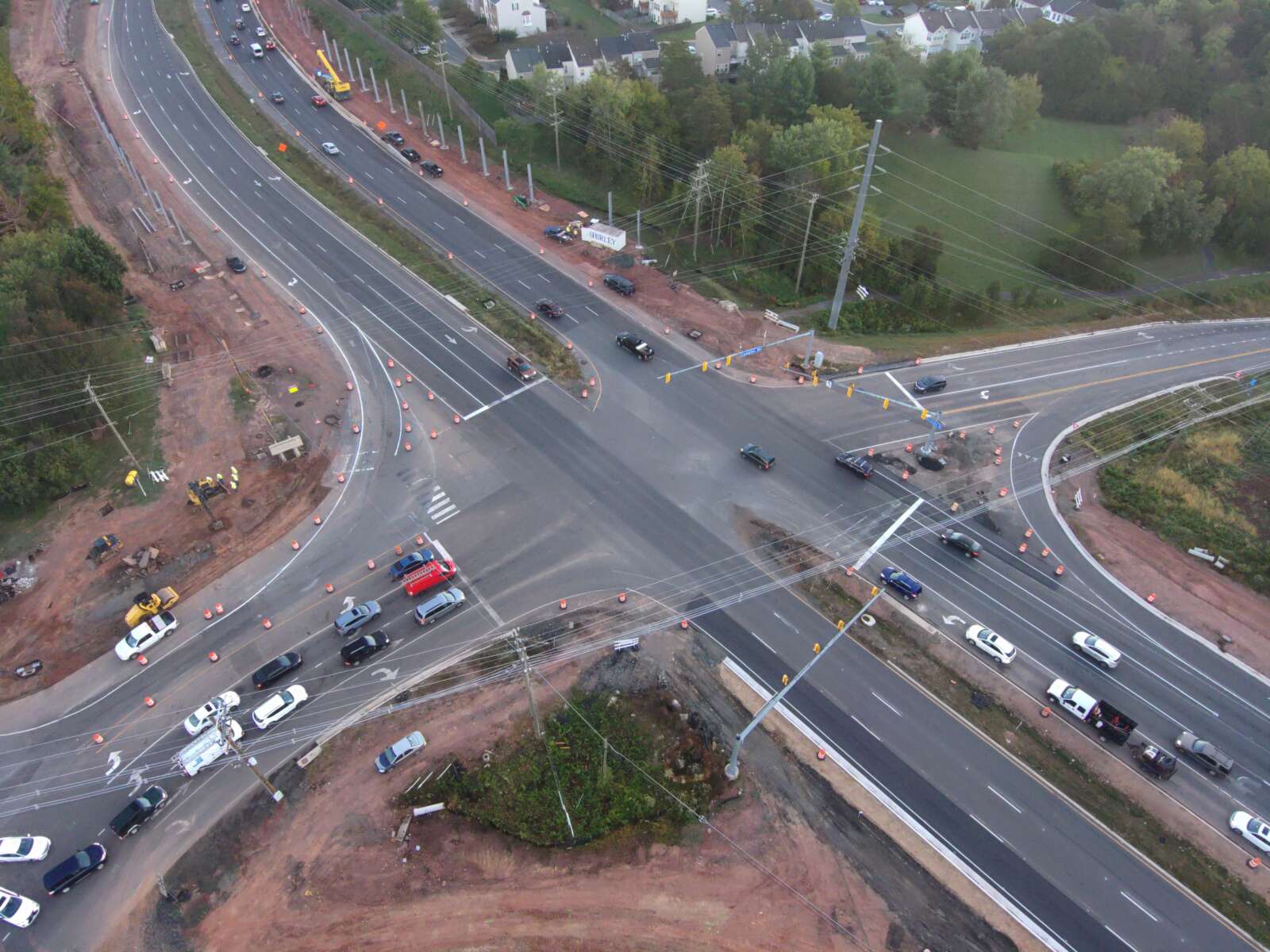
(Updated at 12:05 p.m.) The Centreville section of Route 28 is now two lanes wider and, local officials hope, noticeably less challenging to travel.
Construction is substantially complete on the project to widen Route 28 (Centreville Road) from four to six lanes between the Bull Run bridge at the Fairfax and Prince William county line and Route 29.
Fairfax County elected representatives joined regional and state transportation officials at the Centreville United Methodist Church Park and Ride (6400 Old Centreville Road) for a ribbon-cutting yesterday (Wednesday) to celebrate the milestone, which arrived right on schedule with two new lanes opening in early October.
“The anticipation surrounding this project in our community is palpable, with residents eagerly looking forward to the profound improvements in accessibility and…efficiency this project promises to bring,” Sully District Supervisor Kathy Smith said at the ceremony. “The successful execution of the Route 28 widening project is poised to significantly enhance the quality of life for our residents.”
Under construction since September 2021, the Route 28 widening is intended to reduce traffic, improve safety and provide more transportation options on a highway that sees approximately 60,000 vehicles a day, according to the Fairfax County Department of Transportation.
In addition to the new lanes, the $79.5 million project constructed a 10-foot-wide shared-use path for pedestrians and bicyclists on both sides of the roadway. It also made improvements to intersections and side streets, including installing upgraded traffic signals and removing some median breaks and crossovers.
“Whenever we make road improvement projects like this in Fairfax County, we focus on not just the road improvements, which are absolutely critical to moving traffic and people, but also all the multimodal improvements, improvements for pedestrians and safety improvements for people who live along this corridor,” Fairfax County Board of Supervisors Chairman Jeff McKay said.
Work is expected to continue until May 2024 on some of those elements, including the shared-use paths, noise barriers, storm water management facilities and side street improvements.
However, FCDOT says drivers have already reported shorter trips and less cut-through traffic.
“Morning rush-hour commuters from Manassas Park to I-66 have reported experiencing a reduction in their commute of 10-15 minutes each day,” the department said. “They have also reported a reduction in morning rush hour cut through/bypass traffic on Ordway Road and Old Centreville Road.”
A study conducted by the Virginia Department of Transportation in 2015 found that widening Route 28 would shave about 15 minutes off current travel times, though trips through the 5-mile stretch were still projected to take 40 minutes in the morning due to the area’s increased density and development.
Benefitting Loudoun and Prince William counties, as well as Fairfax, the Route 28 widening has “regional significance,” Northern Virginia Transportation Authority CEO Monica Backmon said. The regional transportation planning agency contributed $26 million to the project, which also got local, state and federal funds.
(Correction: The spelling of Monica Backmon’s name has been fixed.)
Lauding the “innovative design” of the expanded roadway, which could be widened even further to eight lanes in the future, Springfield District Supervisor Pat Herrity highlighted the project’s benefits for his constituents, even though it’s in the Sully District.
“Much of the benefit from this project will be felt in the Springfield District, as we start the process of alleviating all the cut-through traffic in the Occoquan watershed and through the Town of Clifton,” he said. “Those are people who really should be using this route, but it’s too congested. This project is the first step in making it less congested.”
The next step, Herrity said, is for Prince William County to widen Route 28 to six lanes on its side of the border. A preliminary design for that bypass project was presented in the spring, but construction isn’t slated to start until 2026.
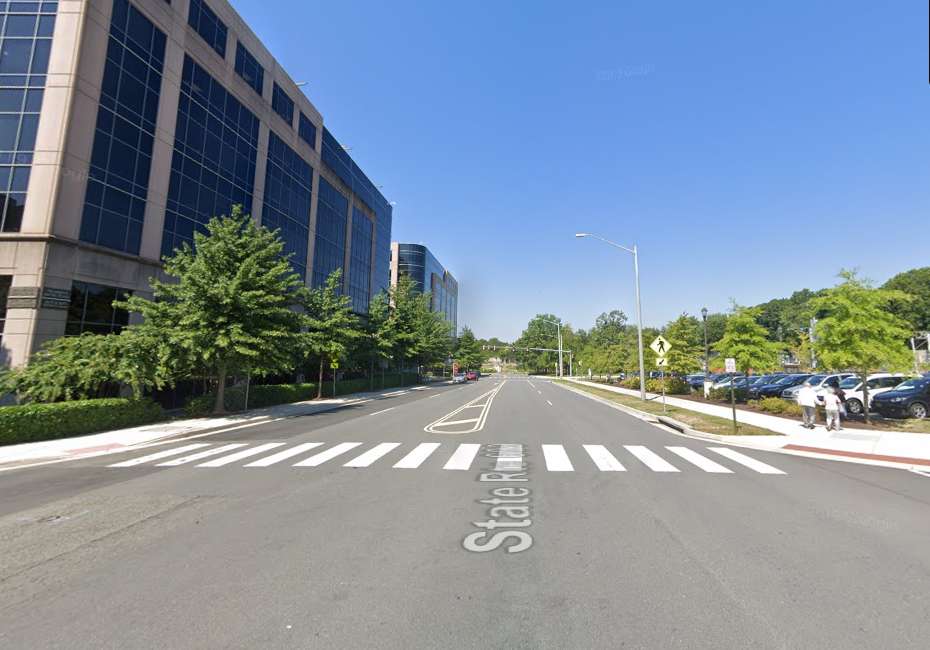
Fairfax County is designing a new layout for Prosperity Avenue near the Dunn Loring Metro station.
The new configuration will reduce the roadway from four to two lanes by adding a road diet and protected bicycle lanes between Gallows Road and Prosperity Metro Plaza, the two-building office center whose tenants include U.S. Customs and Immigration Services’ D.C. field office.
The project will also convert existing on-street bicycle lanes that start to the west and continue until Hilltop Road into protected bike lanes.
Design funding will come from the Metropolitan Washington Council of Governments (COG), whose Transportation Planning Board awarded $80,000 to the project last week as part of its Transit Within Reach program.
COG is “excited” about the county’s proposed improvements to Prosperity Avenue, which currently has a “very wide” design that “encourages drivers to speed and discourages people from walking and biking,” according to John Swanson, the principal transportation planner for the regional nonprofit.
The affected section of Prosperity Avenue has a 35 mph speed limit. A 19-year-old man from Chantilly was killed in a crash on the road last December, but that occurred to the south between Route 29 and Arlington Blvd.
“This part of Fairfax is undergoing a lot of change and the county is really committed to making the Dunn Loring station the center of a vibrant, walkable community,” Swanson said. “…This kind of project will make a real difference at the local level and will serve as a model for the region.”
The idea for the Prosperity Avenue safety project emerged out of discussions that started in April between representatives of businesses along the roadway and Providence District Supervisor Dalia Palchik’s office.
Since then, the district office has been working with county and state transportation staff to develop their proposal.
“I am delighted to see that this project design was approved for funding!” Palchik said in a statement. “After hearing from local businesses about safety concerns for their staff and visitors, my office worked diligently with FCDOT and VDOT on a proposal for a road diet for Prosperity Avenue. This design work will help improve safety for our pedestrians, especially for staff and community members visiting the USCIS offices or attending naturalization ceremonies.”
The Transit Within Reach funds will cover the project design up to 30% completion, according to the Fairfax County Department of Transportation. That will encompass the bicycle lanes from west of the Metro station to Hilltop Avenue, which is expected to be completed around the end of 2024.
The COG funding will also give the county an estimate for how much it’ll cost to implement the project.
“Once complete, FCDOT will identify funding to complete the design and construct the project,” a department spokesperson said.
Launched in 2021, the Transit Within Reach program provides consulting services for the design and preliminary engineering of “small, high-impact bicycle and pedestrian projects,” per COG.
The Transportation Planning Board approved a total of $250,000 in funding from the program at its meeting last Wednesday (Oct. 18). The other projects were a shared-use path in Gaithersburg and a sidewalk in D.C.
FCDOT is also working on a separate study to identify potential improvements on Gallows Road. Staff told community members at a meeting last month that traffic congestion, crashes, a lack of sidewalks and general pedestrian, bicycle and transit safety are all issues on the 7-mile corridor, Annandale Today reported.
While that study won’t assess or make recommendations for Prosperity Avenue, it could “be informed” by the road diet and bicycle lanes project, according to FCDOT.
Image via Google Maps
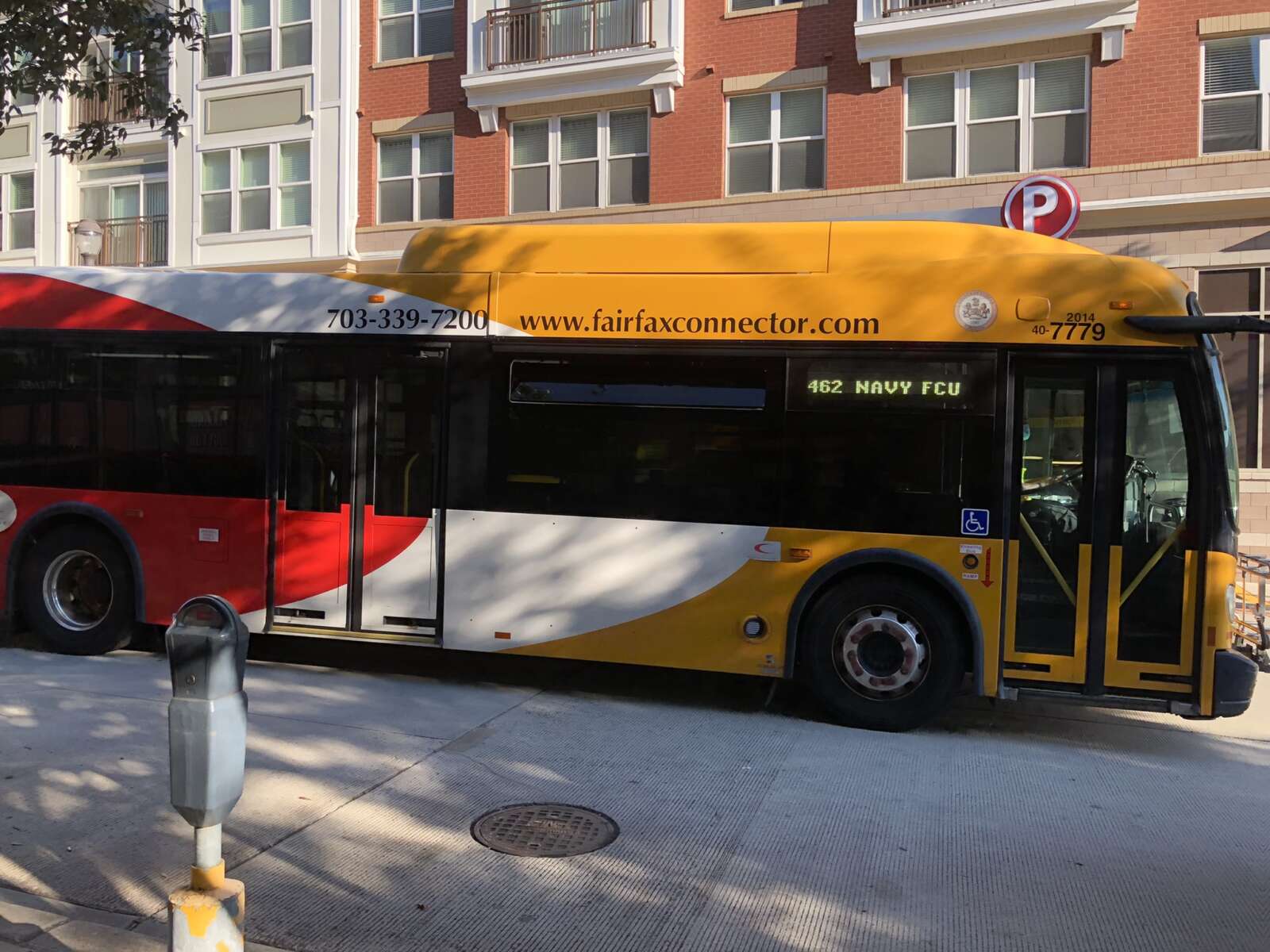
Negotiations over pay, benefits and working conditions are underway for hundreds of Fairfax Connector employees.
Amalgamated Transit Union Local 689 presented an initial proposal on Oct. 13 for a contract that would cover 546 members who work for Fairfax County’s bus system to Transdev, the company that operates the transit service, the union said in a press release yesterday (Monday).
With its current contract set to expire Nov. 30, the union says workers are seeking wage increases “to keep competitive with other transit companies,” improved sick leave, retirement security for current and future employees and standard 40-hour, 5-days-per-week schedules at all bus garages.
However, bargaining sessions scheduled for yesterday and today (Tuesday) were canceled over the weekend by Transdev, according to ATU Local 689, which said it was told the contractor “would not be ready to counter” its proposal.
“It is extremely disappointing that while Local 689 worked tirelessly to craft a new contract proposal and prepared to bargain in good faith, Transdev has apparently failed to do the same,” Local 689 President Raymond Jackson said in a statement. “Our members providing a public service in Fairfax County are dedicated professionals who deserve a fair contract. Local 689 remains committed to advocating for our members and is ready to meet with Transdev to negotiate the new contract. We hope Transdev prioritizes the contract talks and its employees, not profit.”
FFXnow reached out to a Transdev spokesperson for comment but didn’t hear back by press time.
The largest local bus system in Northern Virginia, Fairfax Connector transports about 26,000 passengers per day across 93 different routes, according to its website.
Though ridership plummeted in the first two years of the pandemic, it bounced back starting last summer, and this June, it surpassed 2019 levels with more than 774,000 riders for the month, according to data reported by the Virginia Department of Rail and Public Transportation.
When the Connector’s workers last had contract negotiations in 2019, bus drivers and mechanics — who were represented at the time by a different ATU chapter, Local 1764 — went on strike for four days before the union and Transdev signed a back-to-work agreement. Workers eventually ratified a new, four-year contract on Feb. 29, 2020, averting the possibility of a second strike.
According to a Local 689 spokesperson, Connector workers were assigned to their current chapter after Local 1764 went into receivership in 2021.
ATU Local 689, whose 15,000-plus members include employees of Metrobus and Alexandria’s DASH, welcomed former Local 1764 members on March 25, 2021, stating that “the companies kept us apart” even though members did the same work, often in the same garages.
This year’s negotiations are taking place in a different environment for organized labor, which has gained public support in the wake of the COVID-19 pandemic.
After authorizing a strike, local office cleaners won pay bumps earlier this month that their union called “historic,” and Kaiser Permanente workers secured 21% raises following a three-day strike on Oct. 4-6. The United Auto Workers expanded a strike against vehicle manufacturers in Detroit yesterday, while negotiations between Hollywood studios and the actors’ union, SAG-AFTRA, are slated to resume today — 103 days after they went on strike.
The Fairfax County Department of Transportation has a five-year, $443 million contract with Transdev, which took over the Connector’s operations and maintenance in July 2019 from the previous contractor, MV Transportation, according to previous reporting by the Washington Post.
“FCDOT Connector has no comments about this matter at this time,” FCDOT said when asked about the current talks.
Fairfax County Board of Supervisors Chairman Jeff McKay, who met with the union and Transdev to resolve the 2019 strike, says he has “not been privy” to the new contract discussions, since they’re still at a relatively early stage.
“My hope is that Transdev and the members of ATU Local 689 can come to a mutually agreeable contract that prevents a disruption of service,” McKay told FFXnow.
According to Local 689, there are three scheduled bargaining sessions remaining before the contract expires next month. The union claims that Transdev dragged its feet on providing available dates earlier this year.
“Local 689 is in the process of rescheduling the sessions with Transdev, and is more than willing to add additional sessions if needed,” the union said.
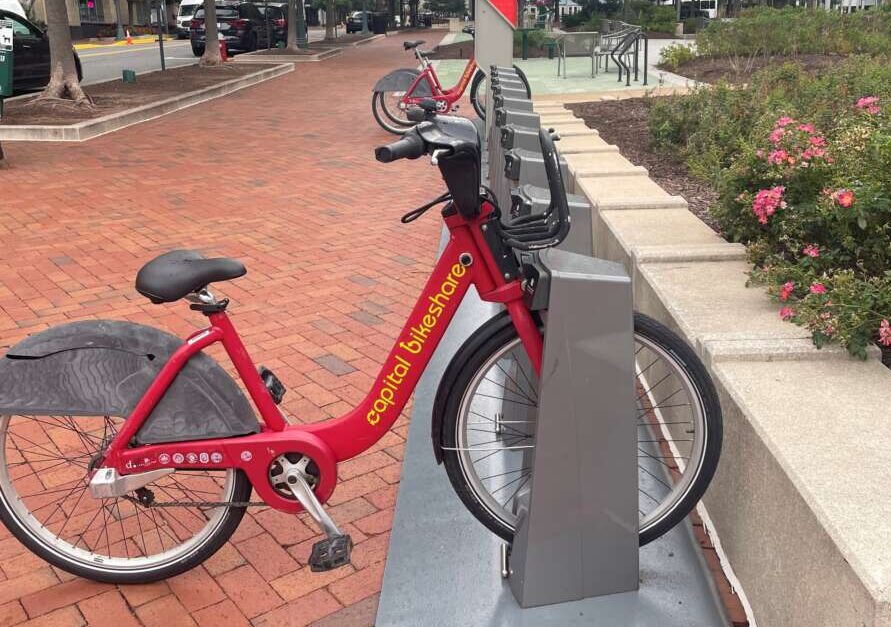
A total of six new Capital Bikeshare stations may soon arrive around the Innovation Center Metro station.
The Fairfax County Department of Transportation will host a meeting this coming Wednesday (Oct. 4) to discuss the proposal. The virtual meeting begins at 7 p.m.
So far, proposed locations include:
- Innovation Metro South
- Corta Way and Sayward Boulevard
- Coppermine Road and River Birch Road
- Dulles Technology Drive and Sunrise Valley Drive
- Woodland Park Road and Cooperative Way
- McNair Farms Drive and Thomas Jefferson Drive
Comments on the proposal will be accepted through Friday, Oct. 20.
County staff will then work with supervisors John Foust (Dranesville) and Walter Alcorn (Hunter Mill) as well as the Virginia Department of Transportation to install the equipment sometime next year, according to Freddy Serrano, a spokesperson for FCDOT.
“The recently opened Innovation Center Metro provides an ideal first and last mile destination for Capital Bikeshare riders. County staff also wanted to propose expansion into Supervisor Districts with few, if any existing stations such as [the] Dranesville District,” Serrano wrote in a statement.
The new stations are funded by a grant from the Federal Highway Administration. The grant covers a total of 10 stations and roughly 69 electric bicycles. Capital Bikeshare has 738 stations in the D.C. area, 79 of which are located in Fairfax County.
Next week’s meeting will also include an update on Bikeshare’s new electric bicycles, which started rolling out this spring.
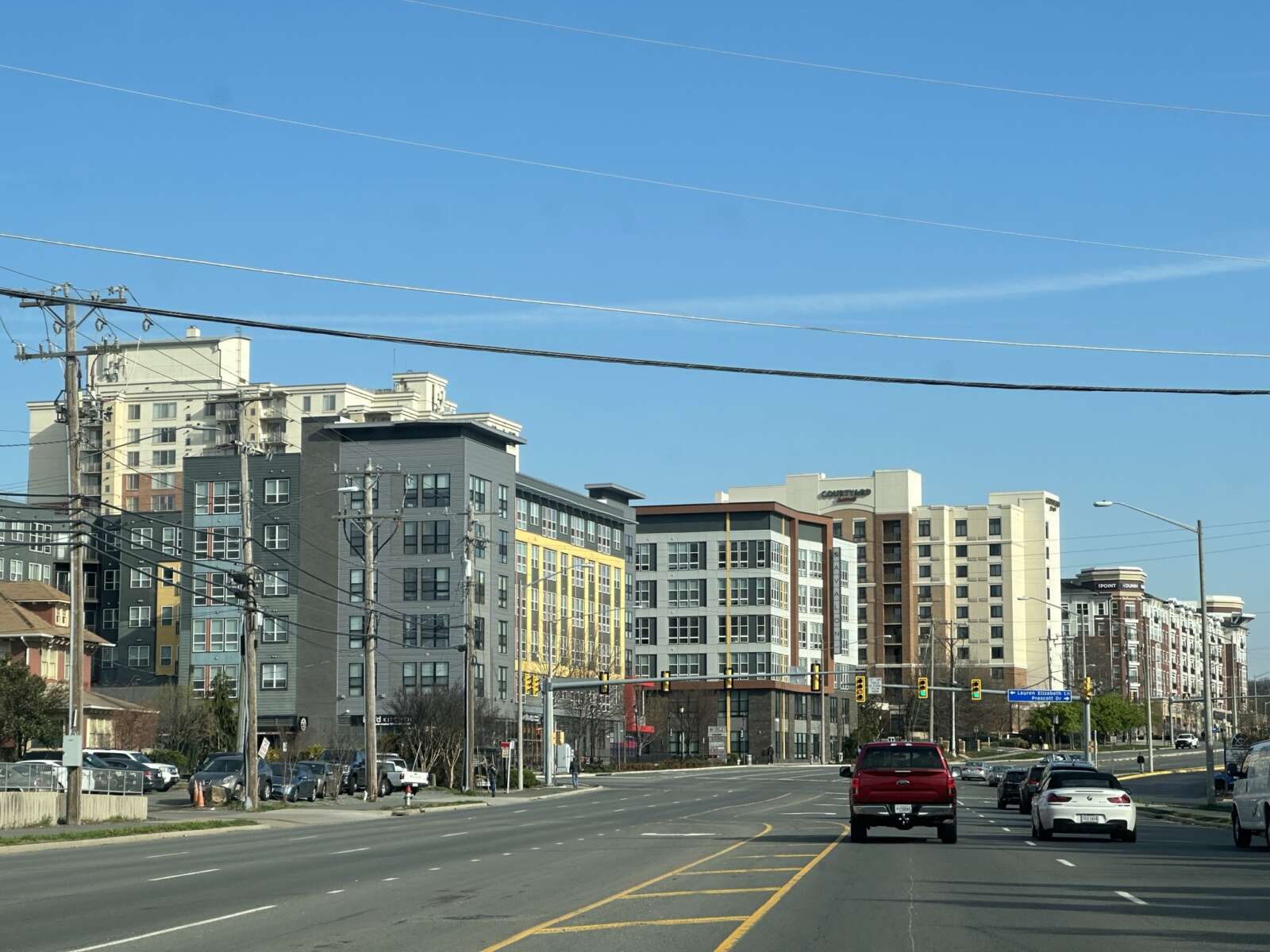
The Fairfax County Department of Transportation is ready to take a hard look at the future of Gallows Road.
The department will introduce a Gallows Road Multimodal Study with two public meetings next week, seeking feedback on enhancing mobility and safety along the major road between Tysons and Annandale. It will also give an update on the current travel conditions.
According to FCDOT communications head Freddy Serrano, the study is needed to address various transportation and connectivity challenges in the Gallows Road corridor.
“[Those include] pedestrian and bicycle facilities, limited mobility options, traffic conditions, and barriers created by I-495,” he said. “It aims to explore opportunities to mitigate these barriers and improve multimodal mobility between the planned land uses on the east and west sides of the interstate.”
Serrano says the goal is to find solutions and improve accessibility for everyone who uses the corridor, while supporting planned development.
Merrifield in particular is poised for growth. This spring, the county designated proposals to redevelop aging buildings in the area as top priorities for review, and plans to convert former Inova office buildings into live/work units recently raised concerns about traffic backups at the Gallows and Gatehouse Road intersection.
“Additionally, the study is essential for securing funding and planning for transportation infrastructure projects that align with the goals of the comprehensive plan and accommodate future development,” Serrano said.
The study stems from a comprehensive plan amendment that the Fairfax County Board of Supervisors approved in 2019, opening up the Merrifield Suburban Center to more mixed-use development. With the vote, the board also directed staff to:
- Conduct a comprehensive study of multimodal transportation opportunities
- Study the barriers to connectivity in the Merrifield suburban center created by I-495, and opportunities to mitigate the barriers
- Develop a funding plan for the transportation infrastructure improvements recommended in the Merrifield suburban center comprehensive plan.
The study started late last year, and it’s expected to wrap up by 2024.
“Overall, the study aims to improve transportation infrastructure and connectivity within the Merrifield suburban center and along Gallows Road to support sustainable development and enhance mobility for residents and stakeholders in the area,” Serrano said.
The first meeting is scheduled for Tuesday, Sept. 19. at 7 p.m. and will be virtual. A second meeting will be held in person at Luther Jackson Middle School (3020 Gallows Road) on Wednesday, Sept. 20 at 7 p.m.
Comments will be accepted until the end of the business day on Friday, Oct. 6.
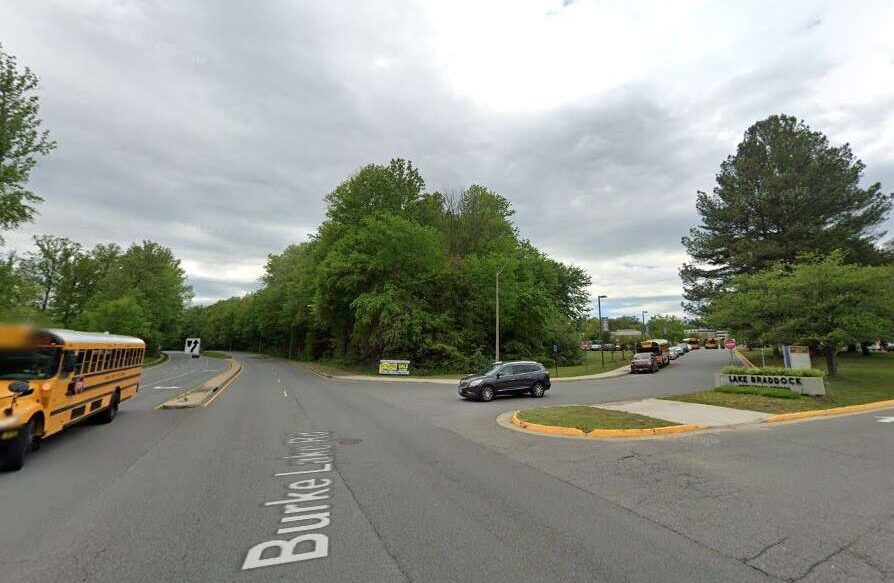
Fairfax County is making another push to fund pedestrian safety improvements at Shrevewood Elementary School in Idylwood.
The long-gestating crosswalks project is one of five that the Fairfax County Department of Transportation intends to submit to the state for funding consideration under the federal Transportation Alternatives grant program.
“This program invests in community-based projects that expand non-motorized travel choices and enhance the transportation experience by improving the cultural, historical and environmental aspect of the transportation infrastructure,” FCDOT said in a press release last week.
For fiscal year 2025, which starts July 1, 2024, the department will request a total of $9.2 million to fill walkway gaps to the Mason Neck Trail in Lorton, add a shared-use path on Compton Road in Centreville, and support three Safe Routes to Schools projects — a program that encourages students to walk and bike to school.
Shrevewood Elementary School — Safe Routes to School
- Total estimated cost: $2.99 million
- Grant request: $1.14 million
Part of a larger effort to improve safety in the Shreve Road corridor after a fatal crash in 2019, this project will add marked crosswalks at Fairwood Lane, the school’s eastern driveway and across Virginia Lane at Virginia Avenue. The Fairwood Lane crosswalk will include a pedestrian refuge island.
FCDOT says the crosswalks “will provide neighborhood access to school amenities” and the nearby Washington & Old Dominion Trail.
Bush Hill Elementary School — Safe Routes to School
- Total estimated cost: $3.66 million
- Grant request: $1.86 million
Approximately 850 feet of sidewalk will be added on Bush Hill Drive between Ninian Avenue and Larno Avenue in Rose Hill.
“Completing this missing sidewalk link will improve safety and accessibility for children walking and bicycling to school,” FCDOT said.
Lake Braddock Secondary School — Safe Routes to School
- Total estimated cost: $2.55 million
- Grant request: $2.04 million
Crosswalks and a pedestrian signal will be constructed at the school’s entrance on Burke Lake Road. The project will also reconstruct a sidewalk on the road’s south side to be 6 feet wide and bring six ramps up to ADA standards.
Mason Neck Trail
- Total estimated cost: $13.96 million
- Grant request: $1.7 million
The project will build missing pieces of the walkway along Gunston Road from Richmond Highway (Route 1) to the existing trail.
Compton Road Walkway
- Total estimated cost: $9.3 million
- Grant request: $2.5 million
Approximately 550 feet of a 10-foot-wide, paved shared use path will be added on the east side of Compton Road, connecting the Cub Run Stream Valley Trail with an existing path crossing to the Bull Run Regional Events Center’s entrance.
The project will also widen a bridge over Cub Run to accommodate the shared use path.
FCDOT Communications Specialist Lynn Krolowitz noted that the grant request amounts could be revised if the project cost estimates changed before the applications are finalized in October.
“FCDOT select projects based on several factors such as program eligibility criteria and project readiness requirements, the need of continued funding for existing projects, and previous Board approval/consideration, which assumes some level of public involvement,” Krolowitz said in an email to FFXnow.
To be eligible for Transportation Alternatives grants, projects must have already gotten public feedback, be ready for design, require less than four years of construction, have a “logical” endpoint — such as an existing sidewalk or a road intersection — and be beneficial even if no other improvements are made in the area, according to FCDOT.
Three of the projects under consideration in this round, including the Shrevewood project, have previously gotten the grants, giving them priority in the selection process, Krolowtiz says.
FCDOT will host a virtual public input meeting to discuss the proposed projects at 6 p.m. tomorrow (Wednesday).
Image via Google Maps
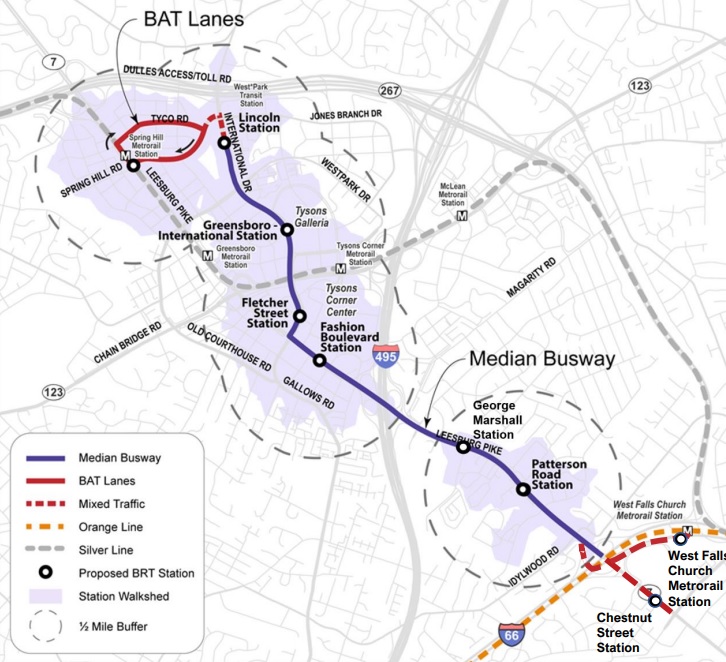
Whenever Route 7 (Leesburg Pike) gets widened, the new lanes from International Drive in Tysons down to the West Falls Church Metro station area will be reserved exclusively for a future bus rapid transit (BRT) system.
The Fairfax County Board of Supervisors approved a comprehensive plan amendment last Tuesday (July 25) incorporating the BRT into the county’s vision for Route 7 and International Drive, a move that enables county staff to pursue funding.
“I do think this is an important movement forward in this project,” Providence District Supervisor Dalia Palchik said after a public hearing.
The Tysons portion of the Route 7 BRT — which is intended to provide faster, more direct service than a traditional local bus route — is part of a regional system that the Northern Virginia Transportation Commission has been planning for a decade now. The finished route will extend into Falls Church City and Seven Corners, ending at the Mark Center in Alexandria.
For the initial Tysons phase, though, the Fairfax County Department of Transportation has settled on the West Falls Church Metro as the southern endpoint and the Spring Hill Metro station as the northern terminus.
Adhering to an alignment approved by the Board of Supervisors in 2021, the BRT will have nine stops:
- The West Falls Church Metro station
- Westbound Route 7 (Leesburg Pike) at Chestnut Street
- Patterson Road, near the Tysons Station and Idylwood Plaza shopping centers
- George C. Marshall Drive
- Fashion Blvd, serving Tysons Corner Center
- International Drive and Fletcher Street
- International and Greensboro Drive, next to Tysons Galleria
- International and Lincoln Circle, near the Rotunda Condominiums
- Spring Hill Metro station
Along with establishing the potential stations, the newly approved amendment designates two additional lanes planned for Route 7 from Haycock Road to International Drive as dedicated BRT lanes.
The comprehensive plan recommends expanding Leesburg Pike from four to six lanes between Haycock and the Capital Beltway (I-495) and from six to eight lanes between the Beltway and Route 123. Funds have already been secured to design the Beltway to Route 123 segment. Read More
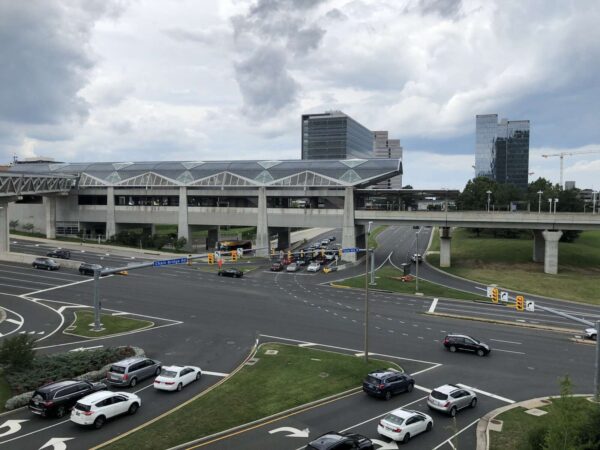
Local officials are in the midst of developing a data-driven way to prioritize and implement spot transportation improvements throughout Fairfax County.
The spot improvement screening program, which was discussed at a Fairfax County Board of Supervisors’ transportation committee meeting on July 18, lets the county identify priority locations for new transportation improvements, especially along intersections.
The program also intends to prioritize safety as a metric to evaluate transportation.
So far, the county has identified 287 projects as high priority out of a total of 3,966 reviewed locations. Roughly 46% of the spots already have a planned project nearby, according to the county.
The Dranesville District had the most spots, but the majority of them were categorized as “low priority.” The Franconia and Mason districts led the way in terms of high-priority spots.
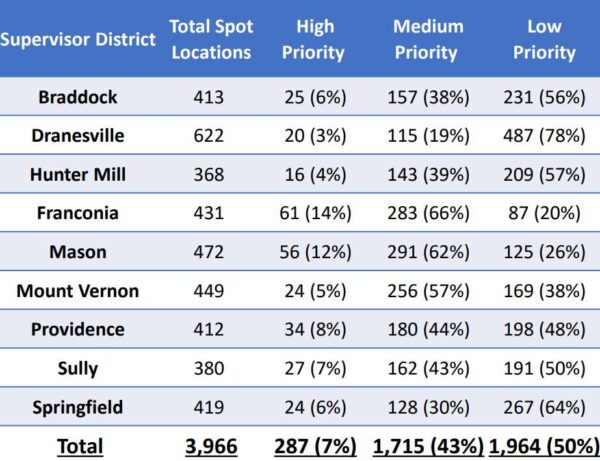
Underway since 2021, the county’s methodology prioritizes safety while also considering equity and the multimodal nature of the area, Fairfax County Department of Transportation staff said.
The county is in the midst of finalizing locations for each district. Evaluation and implementation is contingent on approval by the Board of Supervisors.
FCDOT staff recommend focusing on high priority locations and working with the Virginia Department of Transportation to strategize funding for projects. Staff also suggested further narrowing spots where there are no programmed safety-related projects.
If approved, the spot improvement program could get renewed every three to five years.
While the full list of possible spot improvements was not released at the meeting, Vanessa Holt from FCDOT’s traffic engineering section said that public input will be solicited on projects.
“Our program recommendations include focusing on the high priority spot locations,” Holt said.
At the meeting, supervisors asked staff to consider other elements in their evaluations. Hunter Mill District Supervisor Walter Alcorn suggested incorporating near-misses, camera data from VDOT, and other data points into the prioritization process.
“I really like the process, the drivers being data-driven,” Alcorn said.
The program, which is not yet funded, is different from the county’s active transportation program, which sets aside $100 million for improvements for pedestrians, bicyclists and other non-motorized travelers.
Board Chairman Jeff McKay also emphasized that not all traffic fatalities are linked to road safety issues.
“Unfortunately, we do have fatalities in some corridors of the county. It’s not a road design issue at all,” McKay said.
He also added that the proximity of other projects to prioritized spot improvement locations shouldn’t automatically downgrade a project from the list. Instead, the location may be a strategic area to kill two birds with the same stone.
Others like Springfield District Supervisor Pat Herrity noted that funding for these projects may not be available for several years, resulting in the need to manage public expectations about implementation.
Holt acknowledged that the public’s feedback is critical as the process moves forward.
“We recognize that data analysis is not perfect when we have that human element in transportation safety,” Holt said.
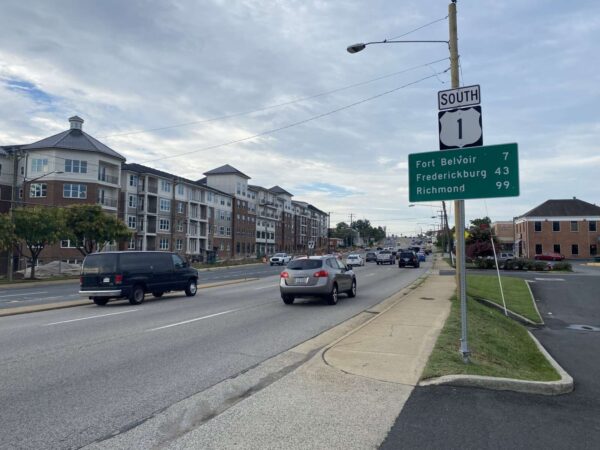
(Updated 10:55 a.m. on 7/26/2023) The ongoing redevelopment of Richmond Highway (Route 1) in Fairfax County has sparked a larger discussion over whether the benefits of road widening projects outweigh their potential harm.
The Virginia Department of Transportation plans to bring improvements to a three-mile stretch in the Richmond Highway corridor in two phases: first from Jeff Todd Way to just north of Frye Road, then from just north of Frye Road to Sherwood Hall Lane.
Notably, the changes will widen Richmond Highway from four to six lanes, which will pave the way for bus rapid transit in the corridor but has garnered some pushback from local community members.
The Coalition for Smarter Growth, which advocates for more “sustainable” transportation methods such as walking, biking and transit in the D.C. region, claimed in a recent press release that “wider roads fail, and the public knows this.”
CSG’s Northern Virginia Advocacy Manager Sonya Breehey says road widening projects create induced demand, arguing that adding more travel lanes incentivizes more people to drive and increases congestion in the long run, despite offering short-term relief.
“The idea is, we get stuck in traffic, so we add travel lanes,” Breehey said. “It’s easy for a few years, but then those travel lanes fill back up and then everybody’s clamoring again for more road widening. It’s a cyclical problem.”
Rep. Don Beyer, who represents the county’s Route 1 area in Congress, told FFXnow in an exclusive interview that he supports road widening projects.
“I think [road widening projects] are an important part of congestion relief,” Beyer said. “There’s an alternative argument…that they will fill up as fast as you build them. That’s certainly been largely true in the metro D.C. area for a long time…but at the same time, I don’t know if it’s still true today.”
In addition to adding travel lanes, the Richmond Highway project reserves median space for future lanes dedicated to The One, a bus rapid transit system that aims to outpace traditional bus services with dedicated lanes and fewer stops.
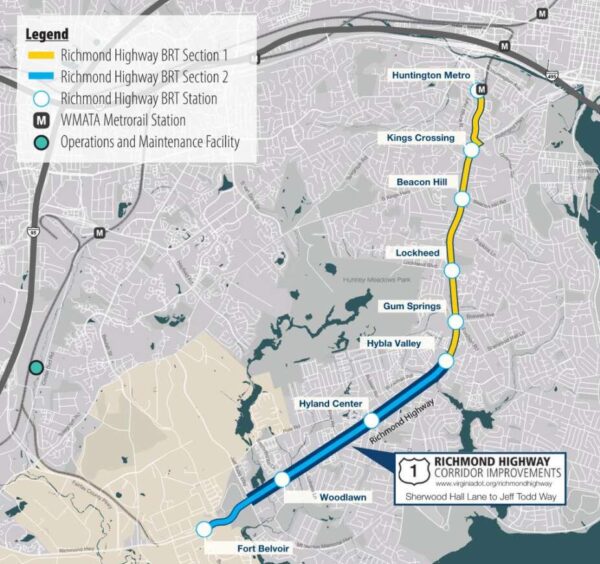
With the BRT expected to be operational in 2030, the Northern Virginia Transportation Commission announced last month that the Commonwealth Transportation Board approved $10 million to help implement the bus system from Fort Belvoir to the Huntington Metro station.
“This billion-dollar investment in a new state-of-the-art transportation system and in the communities along Richmond Highway will revitalize the area and provide more safe, convenient and dependable transportation options for the people who live here,” Mount Vernon District Supervisor Dan Storck wrote in a statement.
Storck says road widening can only be “done right” if it is “in coordination” with “walkable, bikeable communities and mass transit.” Read More

